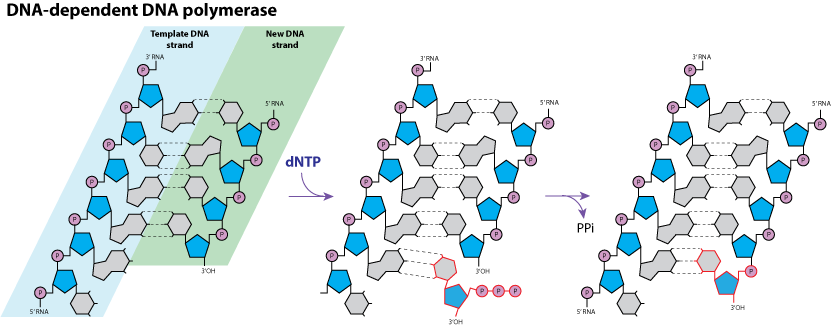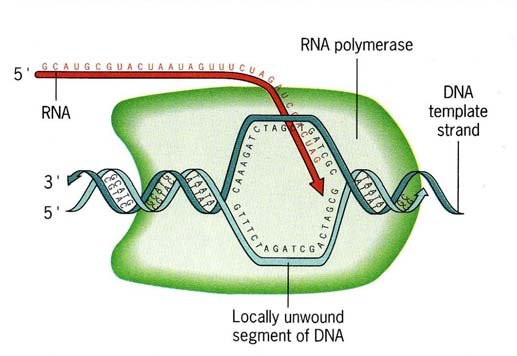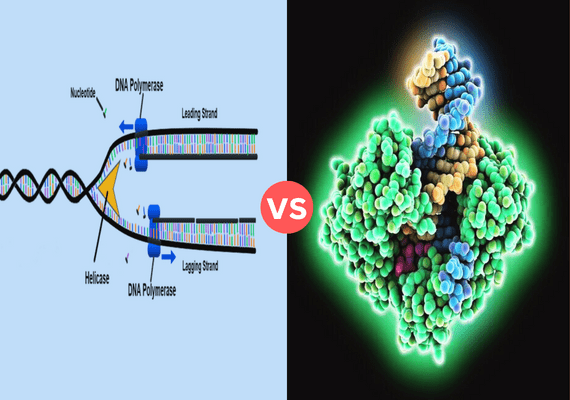DNA Dependent DNA Polymerase vs DNA Dependent RNA Polymerase
DNA Dependent DNA Polymerase vs DNA Dependent RNA Polymerase is that DNA-dependent DNA polymerase catalyzes the synthesis of double-stranded DNA molecules during DNA replication. DNA-dependent RNA polymerase catalyzes the production of single-stranded molecules primarily during transcription.
DNA is the material that makes up our genetic makeup as well as nearly all living organisms. It is a polymer composed of two polynucleotide chains that wrap around one another, creating a double helical structure.
With respect to DNA DNA polymerase and RNA polymerase are the two different enzymes that perform their functions in a DNA-dependent way. Both enzymes are vital when it comes to the transcription and replication of DNA.
What is DNA Dependent DNA Polymerase?
DNA-dependent DNA polymerase is an integral component of DNA replication. Its main role is to catalyze the formation of new DNA strands by adding complementary nucleotides onto existing template DNA strands.
DNA-dependent polymerase is a highly specific enzyme designed to synthesize DNA from templates, reading the sequence of each template strand and synthesizing its complementary DNA strand accordingly.

For proper functioning, DNA-dependent DNA polymerase requires an initiating primer strand (either short RNA or DNA) in order to begin this synthesis process. Operates from 5′ to 3′ direction by adding nucleotides from 3′ end of primer inwards.
At each stage of DNA replication, this polymerase plays an essential part in expanding and copying new strands to ensure accurate transmission of genetic information to daughter cells.
Some DNA-dependent polymerases feature proofreading activity to detect and correct errors that arise during DNA replication, thus maintaining accuracy. Individual organisms may possess distinct DNA-dependent DNA polymerases with specific functions and properties.
Structure of DNA Dependent DNA Polymerase
- Catalytic Core: At the core of DNA-dependent DNA polymerase lies its catalytic site responsible for adding nucleotides to an expanding DNA strand. Typically comprised of several subunits working together to catalyze this polymerization reaction.
- Active Site: Within the catalytic core is an “active site”, where nucleotides can be added to a growing DNA chain. This active site features amino acid residues that facilitate binding incoming nucleotides for incorporation into the growing DNA strand.
- Binding Sites: DNA-dependent polymerases have specific binding sites for DNA and the primer-template junction that allow accurate DNA synthesis. Both components must be in their proper positions in the enzyme in order for accurate DNA production.
- Exonuclease Domain: Many DNA-dependent polymerases feature an exonuclease domain for proofreading and error correction during DNA replication. This domain removes incorrectly integrated nucleotides from the growing DNA chain.
- Thumb, Finger, and Palm Domains: Some DNA polymerases contain these structural domains to facilitate movement along a DNA template and binding of new nucleotides.
- Cleft or Active Site Pocket: This area welcomes nucleotides entering DNA chains for addition.
- Metal Ions: DNA polymerase-dependent DNA polymerases often require divalent metal ions such as magnesium (Mg2+) to perform their catalytic activity, helping stabilize the nucleotide triphosphate phosphate groups and speeding up their addition reactions.
What is DNA Dependent RNA Polymerase?
DNA-dependent RNA polymerase is an integral component of transcription, an essential step in gene expression. Primarily, its function is to convert genetic information stored in DNA into functional RNA molecules like messenger RNA (mRNA), transfer RNA (tRNA), and ribosomal RNA (rRNA).
This enzyme exhibits an exceptional degree of specificity for DNA templates, recognizing and binding to specific DNA sequences known as promoters that mark the beginning points for genes.
DNA-dependent RNA polymerase differs from its DNA counterpart in that transcription can start directly at a promoter site on its DNA template rather than needing a primer as an initiator of transcription.

Synthesis of RNA molecules along the 5′ to 3′ direction following complementary base pairing rules creates an accurate copy of DNA templates as an RNA template.
RNA produced by this polymerase plays an essential role in cell processes, aiding the translation of genetic instructions into proteins and transmitting them accurately within living organisms.
Eukaryotic cells possess numerous forms of DNA-dependent RNA polymerases responsible for transcribing various classes of RNA molecules providing more flexibility and diversity when it comes to gene regulation and expression.
Structure of DNA Dependent RNA Polymerase
- Core Enzyme: RNA polymerase’s core enzyme comprises multiple subunits responsible for catalyzing RNA synthesis. In bacteria, this includes five subunits: α, α, β, β’, and ω Eukaryotic RNA polymerases typically have more complex structures with multiple subunits forming its core enzyme.
- Holoenzyme: In addition to the core enzyme, RNA polymerase frequently forms a holoenzyme by associating with various subunits and factors. In bacteria, this includes both the core enzyme and an s (sigma) factor which helps the enzyme recognize promoter sequences on DNA templates for binding purposes; Eukaryotic RNA polymerases interact with various transcription factors and coactivators to form functional holoenzymes.
- Active Site of RNA Polymerase: The active site of RNA polymerase is responsible for catalyzing the addition of new nucleotides to an evolving RNA chain, using amino acid residues that assist with binding ribonucleotide triphosphates and their incorporation into an expanding strand.
- DNA Binding Channel: RNA polymerase has an enzyme that accommodates DNA template strands by binding them within its channel. As it moves along this strand, unwinding it, and synthesizing an RNA strand complementary to it is produced.
- RNA Exit Channel: Once synthesized, RNA leaves its source via an independent channel.
- Bridge Helix: This structural feature helps to secure the DNA-RNA hybrid that forms during transcription.
- Clamp: Some RNA polymerase enzymes feature an “R”-shaped clamp-like structure to secure it to DNA template strands during transcription. This feature helps keep transcription processes running more smoothly.
What are the types of DNA-dependent DNA polymerase and DNA-dependent RNA polymerase?
What are the three types of RNA polymerase?
Eukaryotic cells contain three major types of RNA polymerase enzymes that transcribe various classes of RNA molecules:
- RNA Polymerase I (Pol I): RNA Pol I is responsible for transcribing the genes encoding ribosomal RNA (rRNA). Ribosomal RNA plays an essential role in protein synthesis by providing large precursor molecules of rRNA that will later be processed into smaller ones that make up ribosomes. This step occurs through transcribing these rRNA genes.
- RNA Polymerase II (Pol II): RNA Pol II is an essential player in transcribing protein-coding genes known as messenger RNA (mRNA) genes and their transcription is tightly regulated, making Pol II an integral player in gene expression and regulation. Furthermore, it transcribes some small nuclear RNAs (snRNAs) involved with the processing of messenger RNA.
- RNA Polymerase III (Pol III): RNA Pol III is responsible for transcribing various small RNA genes, such as transfer RNA (tRNA), 5S ribosomal RNA (5S rRNA), and some small nuclear RNAs (snRNAs). While transfer RNA molecules are essential for protein synthesis, 5S rRNA is also an integral component of ribosomes while some small nuclear RNAs (snRNAs) play various roles in processing RNA.
What are the three main types of DNA polymerases in eukaryotes?
Eukaryotic cells contain multiple DNA polymerases; however, the three most prevalent are as follows.
- DNA Polymerase A (Pol a): DNA Pol a is responsible for initiating DNA replication by producing short RNA-DNA primers that serve as starting points for other DNA polymerases like Pol D and E to start synthesizing DNA.
- DNA Polymerase d (Pol d): DNA Pol d is an essential enzyme for replicating DNA accurately by synthesizing most of the new strand on the lagging strand during DNA replication. Working closely with other proteins, it plays a key role in accurately copying all parts of its target DNA molecule.
- DNA Polymerase e (Pol e): Like its counterpart Pol d, DNA Pol e is a key player in DNA replication, synthesizing leading-strand DNA during replication and contributing to accurate and efficient replication of all the genome. Known for its high processivity and fidelity levels, this enzyme helps ensure accurate replication across the genome.
What are the origins of these polymerases in Evolution?
DNA-dependent and DNA-independent polymerases date back to the origins of life and the development of genetic material, serving a critical role in replicating and transcribing genetic information. Their exact evolutionary ancestry remains controversial but experts agree they have deep evolutionary roots.
One prevalent theory suggests that polymerases evolved from simpler RNA-based enzymes under the so-called “RNA world hypothesis.” Under this scenario, RNA molecules served both as genetic material and catalysts for various biochemical reactions.
As DNA emerged as a more stable genetic material, polymerase enzymes evolved specifically designed to replicate and transcribe DNA while continuing its use for various cell functions.
Extremophiles and ancient microorganisms provide vital insights into the evolution of polymerases, as some ancient life forms may resemble early forms of life. Comparative genomics and molecular biology also play a critical role in uncovering this key enzyme’s story of evolution.
DNA-dependent DNA polymerases and DNA-dependent RNA polymerases have their origins tied closely to early life evolution and the transition from an RNA world to DNA as the primary genetic material. Understanding their history provides insight into ancient mechanisms involved with storing and exchanging genetic information.
Functions in Gene Expression
Gene Expression involves many aspects of genetic information processing; two DNA-dependent polymerase enzymes responsible are DNA-dependent DNA polymerase and DNA-dependent RNA polymerase.
DNA-dependent DNA polymerase plays an essential role in gene expression by ensuring accurate replication of DNA during cell division. It synthesizes complementary strands from DNA templates to enable the inheritance of genetic information between generations of cells.
DNA-dependent RNA polymerase is responsible for transcription, the process by which DNA encodes genetic information into RNA molecules. To facilitate transcription at specific promoter sequences, synthesizing complementary strands that complement DNA templates, and contributing to gene regulation by controlling when and how genes are transcribed.
DNA-dependent polymerase plays a crucial role in maintaining genetic information through DNA replication while DNA-dependent RNA polymerase plays an active part in gene expression by transcribing DNA into RNA – this step being essential in transmitting genetic information across cells.
Exploring the Mechanisms of DNA-Dependent RNA Polymerase in Transcription
Exploring the mechanisms of DNA-dependent RNA polymerase during transcription provides insight into the intricate molecular processes underpinning gene expression.
Transcription is a central mechanism in molecular biology, where genetic information encoded in DNA is converted to messenger RNA (mRNA), transfer RNA (tRNA), and ribosomal RNA (rRNA) molecules for further processing by cells.
DNA-dependent RNA polymerase, more commonly referred to as “RNA polymerase,” plays a key role during this critical step in their production and translation into messenger mRNA messengers for processing by cells.
DNA-dependent RNA polymerase is the enzyme responsible for this critical step in molecular biology. At the core of transcription lies its initialization step, where RNA polymerase recognizes and binds to specific DNA sequences known as promoters to initiate the transcription of genes.
Once bound, this enzyme unwinds the double helix to expose single-stranded template strands from which complementary ribonucleotide triphosphates (rNTPs) can then be added sequentially onto growing chains of RNA.
Transcription involves both elongation and termination mechanisms that vary across genes to mark its conclusion. Elongation occurs as RNA polymerase moves along a template DNA strand and synthesizes an RNA strand continuously along its route, unwinding and rewinding DNA with every step.
Termination mechanisms (which vary among genes) signal when transcription has finished. Transcription accuracy and efficiency is controlled by transcription factors, enhancers, and other regulatory elements that directly or indirectly regulate RNA polymerase activity.
This enzyme undergoes conformational changes during transcription to increase processivity and fidelity while posttranscriptional modifications such as capping, splicing, and polyadenylation further refine the structure and function of its product RNA product.
Difference Between DNA Dependent DNA Polymerase and DNA Dependent RNA Polymerase
DNA-dependent DNA polymerase activates the DNA replication process to create double-stranded DNA molecules, whereas DNA-dependent RNA polymerase is responsible for catalyzing the transcription process to produce a single-stranded molecule.
This is the primary distinction between DNA-dependent DNA polymerase as well as DNA-dependent RNA polymerase. DNA-dependent polymerase is dependent on a primer to start polymerization, whereas DNA-dependent RNA polymerase does NOT require a primer in order to start polymerization.
Here’s a simplified comparison chart highlighting the differences between DNA-dependent DNA polymerase and DNA-dependent RNA polymerase:
| Aspect | DNA-dependent DNA Polymerase | DNA-dependent RNA Polymerase |
|---|---|---|
| Primary Function | DNA replication | Transcription |
| Substrate Specificity | DNA templates | DNA templates |
| Primer Requirement | Requires a primer | Does not require a primer |
| Direction of Synthesis | 5′ to 3′ | 5′ to 3′ |
| Role in DNA Replication/Transcription | Involved in DNA replication | Involved in transcription |
| Proofreading Activity | Typically possesses | Typically lacks |
| Examples in Bacteria | DNA polymerase I and III | RNA polymerase in bacteria |
| Examples in Eukaryotes | DNA polymerase δ and ε (in eukaryotes) | RNA polymerase I, II, and III (in eukaryotes) |
| Enzyme Type | Polymerase | Polymerase |
| End Product | New DNA strand | RNA molecule |
| Initiation Site | Origin of replication | The promoter region of a gene |
| Role in Gene Expression | Not involved | Essential for gene expression |
| Function in DNA Maintenance | Maintains genome integrity | Facilitates genetic information transfer |
What are the Similarities Between DNA Dependent DNA Polymerase and DNA Dependent RNA Polymerase?
- DNA-dependent DNA polymerase as well as DNA-dependent RNA polymerase is two enzymes.
- In prokaryotes, both enzymes are present in the cell’s cytoplasm.
- In eukaryotes, both enzymes are located within the nucleus.
- Both carry polymerization functions.
- These enzymes form phosphodiester bonds with nucleotides.
- Both enzymes work in the direction of 5′ – 3′.
- Both kinds of polymerases are crucial for cell division and the synthesis of proteins.
Summary
DNA-dependent DNA polymerase and DNA-dependent RNA polymerase are two enzymes involved in fundamental genetic processes. DNA-dependent DNA polymerase plays an essential role in DNA replication.
By adding complementary nucleotides from a DNA template to form new DNA strands; it needs an initial primer, operates from 5′ to 3′ direction, and often displays proofreading activity examples include DNA polymerase I and III in bacteria.
On the other hand, DNA-dependent RNA polymerase is crucial to transcription processes by synthesizing RNA molecules from DNA templates without needing a primer and operating in a 5′ to 3′ direction.
Typically lacking proofreading activity; for instance, RNA polymerase I-III found in eukaryotes or bacteria may serve this purpose – these enzymes play key roles in maintaining and expressing genetic information in living organisms.

